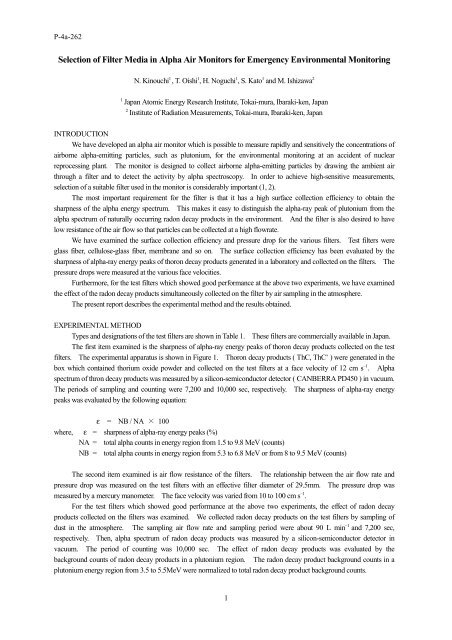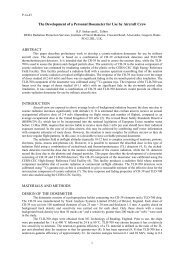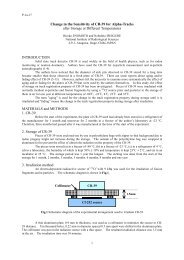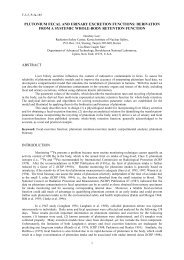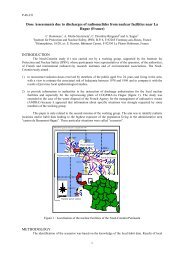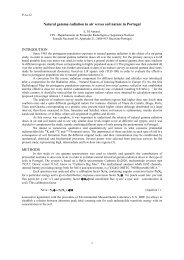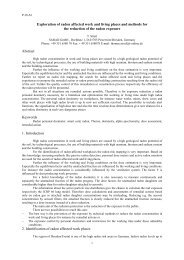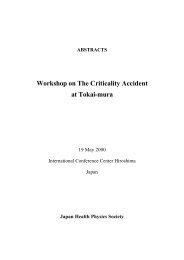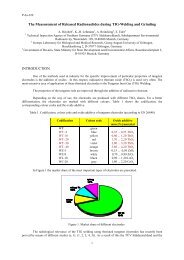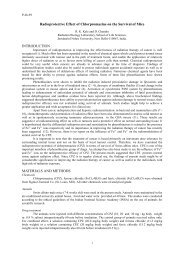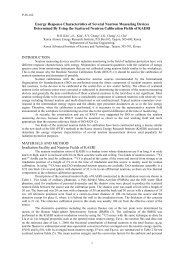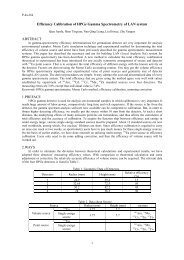Selection of Filter Media in Alpha Air Monitors for Emergency ...
Selection of Filter Media in Alpha Air Monitors for Emergency ...
Selection of Filter Media in Alpha Air Monitors for Emergency ...
Create successful ePaper yourself
Turn your PDF publications into a flip-book with our unique Google optimized e-Paper software.
P-4a-262<br />
<strong>Selection</strong> <strong>of</strong> <strong>Filter</strong> <strong>Media</strong> <strong>in</strong> <strong>Alpha</strong> <strong>Air</strong> <strong>Monitors</strong> <strong>for</strong> <strong>Emergency</strong> Environmental Monitor<strong>in</strong>g<br />
N. K<strong>in</strong>ouchi 1 , T. Oishi 1 , H. Noguchi 1 , S. Kato 1 and M. Ishizawa 2<br />
1 Japan Atomic Energy Research Institute, Tokai-mura, Ibaraki-ken, Japan<br />
2 Institute <strong>of</strong> Radiation Measurements, Tokai-mura, Ibaraki-ken, Japan<br />
INTRODUCTION<br />
We have developed an alpha air monitor which is possible to measure rapidly and sensitively the concentrations <strong>of</strong><br />
airborne alpha-emitt<strong>in</strong>g particles, such as plutonium, <strong>for</strong> the environmental monitor<strong>in</strong>g at an accident <strong>of</strong> nuclear<br />
reprocess<strong>in</strong>g plant. The monitor is designed to collect airborne alpha-emitt<strong>in</strong>g particles by draw<strong>in</strong>g the ambient air<br />
through a filter and to detect the activity by alpha spectroscopy. In order to achieve high-sensitive measurements,<br />
selection <strong>of</strong> a suitable filter used <strong>in</strong> the monitor is considerably important (1, 2).<br />
The most important requirement <strong>for</strong> the filter is that it has a high surface collection efficiency to obta<strong>in</strong> the<br />
sharpness <strong>of</strong> the alpha energy spectrum. This makes it easy to dist<strong>in</strong>guish the alpha-ray peak <strong>of</strong> plutonium from the<br />
alpha spectrum <strong>of</strong> naturally occurr<strong>in</strong>g radon decay products <strong>in</strong> the environment. And the filter is also desired to have<br />
low resistance <strong>of</strong> the air flow so that particles can be collected at a high flowrate.<br />
We have exam<strong>in</strong>ed the surface collection efficiency and pressure drop <strong>for</strong> the various filters. Test filters were<br />
glass fiber, cellulose-glass fiber, membrane and so on. The surface collection efficiency has been evaluated by the<br />
sharpness <strong>of</strong> alpha-ray energy peaks <strong>of</strong> thoron decay products generated <strong>in</strong> a laboratory and collected on the filters. The<br />
pressure drops were measured at the various face velocities.<br />
Furthermore, <strong>for</strong> the test filters which showed good per<strong>for</strong>mance at the above two experiments, we have exam<strong>in</strong>ed<br />
the effect <strong>of</strong> the radon decay products simultaneously collected on the filter by air sampl<strong>in</strong>g <strong>in</strong> the atmosphere.<br />
The present report describes the experimental method and the results obta<strong>in</strong>ed.<br />
EXPERIMENTAL METHOD<br />
Types and designations <strong>of</strong> the test filters are shown <strong>in</strong> Table 1. These filters are commercially available <strong>in</strong> Japan.<br />
The first item exam<strong>in</strong>ed is the sharpness <strong>of</strong> alpha-ray energy peaks <strong>of</strong> thoron decay products collected on the test<br />
filters. The experimental apparatus is shown <strong>in</strong> Figure 1. Thoron decay products ( ThC, ThC’ ) were generated <strong>in</strong> the<br />
box which conta<strong>in</strong>ed thorium oxide powder and collected on the test filters at a face velocity <strong>of</strong> 12 cm s –1 . <strong>Alpha</strong><br />
spectrum <strong>of</strong> thron decay products was measured by a silicon-semiconductor detector ( CANBERRA PD450 ) <strong>in</strong> vacuum.<br />
The periods <strong>of</strong> sampl<strong>in</strong>g and count<strong>in</strong>g were 7,200 and 10,000 sec, respectively. The sharpness <strong>of</strong> alpha-ray energy<br />
peaks was evaluated by the follow<strong>in</strong>g equation:<br />
ε = NB / NA × 100<br />
where, ε = sharpness <strong>of</strong> alpha-ray energy peaks (%)<br />
NA = total alpha counts <strong>in</strong> energy region from 1.5 to 9.8 MeV (counts)<br />
NB = total alpha counts <strong>in</strong> energy region from 5.3 to 6.8 MeV or from 8 to 9.5 MeV (counts)<br />
The second item exam<strong>in</strong>ed is air flow resistance <strong>of</strong> the filters. The relationship between the air flow rate and<br />
pressure drop was measured on the test filters with an effective filter diameter <strong>of</strong> 29.5mm. The pressure drop was<br />
measured by a mercury manometer. The face velocity was varied from 10 to 100 cm s –1 .<br />
For the test filters which showed good per<strong>for</strong>mance at the above two experiments, the effect <strong>of</strong> radon decay<br />
products collected on the filters was exam<strong>in</strong>ed. We collected radon decay products on the test filters by sampl<strong>in</strong>g <strong>of</strong><br />
dust <strong>in</strong> the atmosphere. The sampl<strong>in</strong>g air flow rate and sampl<strong>in</strong>g period were about 90 L m<strong>in</strong> –1 and 7,200 sec,<br />
respectively. Then, alpha spectrum <strong>of</strong> radon decay products was measured by a silicon-semiconductor detector <strong>in</strong><br />
vacuum. The period <strong>of</strong> count<strong>in</strong>g was 10,000 sec. The effect <strong>of</strong> radon decay products was evaluated by the<br />
background counts <strong>of</strong> radon decay products <strong>in</strong> a plutonium region. The radon decay product background counts <strong>in</strong> a<br />
plutonium energy region from 3.5 to 5.5MeV were normalized to total radon decay product background counts.<br />
1
P-4a-262<br />
Table 1<br />
Summary <strong>of</strong> characteristics <strong>of</strong> the test filters<br />
<strong>Filter</strong> Type and Designation Surface collection efficiency (%) Relative pressure drop<br />
(sharpness <strong>of</strong> alpha-ray energy peaks)<br />
GLASS-CELLULOSE FIBER<br />
TOYO HE-40T ( Glass 20%, Cellulose 80%) 45 0.17<br />
TOYO HE-40TA ( Glass 30%, Cellulose 70%) 56 0.20<br />
GLASS FIBER<br />
TOYO GB-100R 65 0.26<br />
PALL-GELMAN T60A20 56 0.11<br />
WHATMAN GF/F 94 1.41<br />
SILICA FIBER<br />
TOYO QR100 76 0.48<br />
MEMBRANE (CELLULOSE ACETATE TYPE)<br />
MILLIPORE AA (0.8 µm pore size) 94 1<br />
TOYO A080A (0.8 µm pore size) 95 1.15<br />
TOYO A100A (1.0 µm pore size) 90 0.76<br />
MILLIPORE SMWP (5.0 µm pore size) 79 0.42<br />
MEMBRANE (PTFE TYPE)<br />
TOYO T080A (0.8 µm pore size) 97 2.11<br />
TOYO T100A (1.0 µm pore size) 98 1.45<br />
TOYO T300A (3.0 µm pore size) 87 0.50<br />
MEMBRANE (PTFE with back<strong>in</strong>g TYPE)<br />
TOYO J100A (1.0 µm pore size) 99 0.63<br />
MILLIPORE FSLW (3.0 µm pore size) 99 0.31<br />
SUMITOMO LWP-300-75 (3.0 µm pore size) 95 0.28<br />
PREFILTER FOR MEMBRANE FILTER<br />
TOYO Y008A 98 1.80<br />
TOYO Y020A 82 0.83<br />
TOYO Y100A 69 0.27<br />
MILLIPORE AW19 91 0.54<br />
Room air dust<br />
Prefilter<br />
Flow meter<br />
Test filter<br />
<strong>Air</strong><br />
Thoron decay<br />
products generator<br />
<strong>Air</strong> pump<br />
Chamber<br />
<strong>Air</strong> pump<br />
Figure 1. Experimental apparatus <strong>for</strong> the exam<strong>in</strong>ation <strong>of</strong> the surface collection efficiency.<br />
2
P-4a-262<br />
Count (nomalized)<br />
1.0<br />
0.8<br />
0.6<br />
0.4<br />
0.2<br />
0.0<br />
GB-100R<br />
Count (nomalized)<br />
1.0<br />
0.8<br />
0.6<br />
0.4<br />
0.2<br />
0.0<br />
FSLW<br />
2000 4000 6000 8000 10000<br />
Energy (keV)<br />
2000 4000 6000 8000 10000<br />
Energy (keV)<br />
Figure 2.<br />
<strong>Alpha</strong> spectrum <strong>of</strong> thoron decay products collected on GB-100R and FSLW.<br />
T080A<br />
GF/F<br />
AA<br />
Pressure drop ( mmHg )<br />
10 2<br />
10 1<br />
AW19<br />
FSLW<br />
GB-100R<br />
HE-40T<br />
10 0<br />
10 1 10 2<br />
Face velocity (cm s -1 )<br />
Figure 3.<br />
Relationship <strong>of</strong> pressure drop to face velocity <strong>for</strong> various test filters.<br />
RESULTS and DISCUSSION<br />
Figure 2 shows the examples <strong>of</strong> alpha spectrum <strong>of</strong> thoron decay products collected on GB-100R (Toyo Roshi Co.<br />
Ltd.) and FSLW ( Millipore Corporation ), respectively. The sharpness <strong>of</strong> alpha-ray energy peaks obta<strong>in</strong>ed <strong>for</strong> test<br />
filters is shown <strong>in</strong> Table 1.<br />
Figure 3 shows the relationship <strong>of</strong> pressure drop to face velocity <strong>for</strong> some test filters. The relative pressure drop<br />
def<strong>in</strong>ed by a ratio <strong>of</strong> the pressure drop <strong>for</strong> the filter <strong>of</strong> <strong>in</strong>terest to that <strong>for</strong> AA ( Millipore Corporation ) at the face velocity<br />
50 cm s –1 is also shown <strong>in</strong> the right column <strong>of</strong> Table 1.<br />
All types <strong>of</strong> fiber filters, except GF/F (Whatman LabSales ) , show poor surface collection efficiencies. GF/F has<br />
a high surface collection efficiency, but this filter is not suitable <strong>for</strong> alpha monitor<strong>in</strong>g because <strong>of</strong> high pressure drop.<br />
All types <strong>of</strong> membrane filter show high surface collection efficiencies. Small pore membrane filters have a tendency<br />
toward high pressure drop. Of membrane filters which have the same 1.0 µm pore size, J100A is superior to the other<br />
filters, A100A and T100A, because J100A has a lower pressure drop and a similar surface collection efficiency to that <strong>of</strong><br />
A100A and T100A. FSLW is a PTFE (polytetrafluoroethylene) membrane filter with polypropylene back<strong>in</strong>g and<br />
LWP-300-75 ( Sumitomo Electric <strong>in</strong>dustries Ltd. ) is a PTFE membrane filter with polyethylene bak<strong>in</strong>g. Both <strong>of</strong> these<br />
filters show a similar per<strong>for</strong>mance to that <strong>of</strong> J100A. In addition, <strong>of</strong> prefilters, AW19 has relatively high surface<br />
collection efficiency <strong>in</strong> spite <strong>of</strong> low pressure drop.<br />
3
P-4a-262<br />
Table 2 Relative background counts <strong>of</strong> radon decay products <strong>in</strong> a plutonium region obta<strong>in</strong>ed <strong>for</strong> the test filters<br />
<strong>Filter</strong> Type and Designation<br />
Relative background counts <strong>of</strong> radon decay products<br />
<strong>in</strong> a plutonium region<br />
MEMBRANE( PTFE with back<strong>in</strong>g TYPE)<br />
MILLIPORE FSLW (3.0 µm pore size) 0.006 ± 0.002<br />
PREFILTER FOR MEMBRANE FILTER<br />
MILLIPORE AW19 (5.0 µm pore size) 0.04 ± 0.005<br />
On the basis <strong>of</strong> these results, we exam<strong>in</strong>ed background counts <strong>in</strong> a plutonium energy region about two filters. We<br />
selected FSLW and AW19 out <strong>of</strong> PTFE membrane filters with back<strong>in</strong>g and prefilters. The relative background counts<br />
<strong>of</strong> radon decay products obta<strong>in</strong>ed <strong>for</strong> the test filters are shown <strong>in</strong> Table 2. This also showed that PTFE membrane filters<br />
with back<strong>in</strong>g such as FSLW is suitable <strong>for</strong> alpha monitor<strong>in</strong>g because <strong>of</strong> lower background counts.<br />
SUMMARY<br />
Some characteristics <strong>of</strong> commercial air filters were studied so as to select the suitable filter media <strong>in</strong> an alpha air<br />
monitor <strong>for</strong> emergency environmental monitor<strong>in</strong>g .<br />
Cellulose acetate membrane filters and PTFE membrane filters without bak<strong>in</strong>g showed high surface collection<br />
efficiency, but these filters are not suitable <strong>for</strong> alpha air sampl<strong>in</strong>g because <strong>of</strong> high pressure drop. It was found that the<br />
PTFE membrane filter with back<strong>in</strong>g had a high surface collection efficiency and low pressure drop. Further research on<br />
the particle collection efficiency <strong>for</strong> the PTFE membrane filters with bak<strong>in</strong>g <strong>of</strong> various pore sizes is required <strong>in</strong> order to<br />
make a choice <strong>of</strong> the optimum pore size.<br />
(This research was conducted under Science Technology Agency Contract. )<br />
REFERENCES<br />
1. L.B.Lockhart,Jr., R.L.Patterson,Jr. and W.L.Anderson, Characteristics <strong>of</strong> <strong>Air</strong> <strong>Filter</strong> <strong>Media</strong> Used <strong>for</strong> Monitor<strong>in</strong>g<br />
<strong>Air</strong>borne Radioactivity. NRL Report 6054, U.S. Naval Research Laboratory, Wash<strong>in</strong>gton D.C., USA (1964)<br />
2. M.D.Hoover and G.J.Newton, Update on <strong>Selection</strong> and Use <strong>of</strong> <strong>Filter</strong> <strong>Media</strong> <strong>in</strong> Cont<strong>in</strong>uous <strong>Air</strong> <strong>Monitors</strong> <strong>for</strong> <strong>Alpha</strong>-<br />
Emitt<strong>in</strong>g Radionuclides. <strong>in</strong> Inhalation Toxicology Research Institute Annual Report, LMF-138, Albuquerque,<br />
USA (1992)<br />
4


